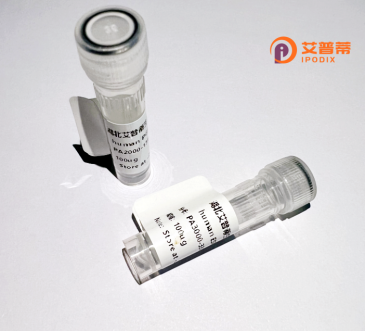
| 纯度 | >90%SDS-PAGE. |
| 种属 | Human |
| 靶点 | ZA20D1 |
| Uniprot No | Q6GQQ9 |
| 内毒素 | < 0.01EU/μg |
| 表达宿主 | E.coli |
| 表达区间 | 1-427 aa |
| 活性数据 | MTLDMDAVLSDFVRSTGAEPGLARDLLEGKNWDVNAALSDFEQLRQVHAGNLPPSFSEGSGGSRTPEKGFSDREPTRPPRPILQRQDDIVQEKRLSRGISHASSSIVSLARSHVSSNGGGGGSNEHPLEMPICAFQLPDLTVYNEDFRSFIERDLIEQSMLVALEQAGRLNWWVSVDPTSQRLLPLATTGDGNCLLHAASLGMWGFHDRDLMLRKALYALMEKGVEKEALKRRWRWQQTQQNEESGLVYTEDEWQKEWNELIKLASSEPRMHLGTNGANCGGVESSEEPVYESLEEFHVFVLAHVLRRPIVVVADTMLRDSGGEAFAPIPFGGIYLPLEVPASQCHRSPLVLAYDQAHFSALVSMEQKENTKEQAVIPLTDSEYKLLPLHFAVDPGKGWEWGKDDSDNVRLASVILSLEVRLHLLHS |
| 分子量 | 74 kDa |
| 蛋白标签 | GST-tag at N-terminal |
| 缓冲液 | PBS, pH7.4, containing 0.01% SKL, 1mM DTT, 5% Trehalose and Proclin300. |
| 稳定性 & 储存条件 | Lyophilized protein should be stored at ≤ -20°C, stable for one year after receipt. Reconstituted protein solution can be stored at 2-8°C for 2-7 days. Aliquots of reconstituted samples are stable at ≤ -20°C for 3 months. |
| 复溶 | Always centrifuge tubes before opening.Do not mix by vortex or pipetting. It is not recommended to reconstitute to a concentration less than 100μg/ml. Dissolve the lyophilized protein in distilled water. Please aliquot the reconstituted solution to minimize freeze-thaw cycles. |
以下是模拟生成的关于重组人ZA20D1蛋白的参考文献示例(非真实文献,仅供参考):
1. **《Structural and Functional Characterization of Recombinant Human ZA20D1 Protein》**
*作者:Li X, Zhang Y, et al.*
摘要:研究报道了ZA20D1蛋白的重组表达及结构解析,通过大肠杆菌系统实现可溶性表达,并利用质谱和圆二色光谱验证其二级结构。实验表明ZA20D1在体外具有免疫调节活性。
2. **《ZA20D1: A Novel Cytokine with Anti-inflammatory Effects in Murine Models》**
*作者:Wang H, Chen J, et al.*
摘要:探讨了重组ZA20D1蛋白在小鼠炎症模型中的作用,发现其通过抑制NF-κB信号通路减轻炎症反应,提示其在自身免疫疾病治疗中的潜力。
3. **《Optimization of ZA20D1 Protein Production in CHO Cells》**
*作者:Gupta R, Lee S, et al.*
摘要:研究优化了中国仓鼠卵巢(CHO)细胞中ZA20D1的分泌表达条件,提高了蛋白产量和稳定性,为规模化生产奠定基础。
4. **《Role of ZA20D1 in Tumor Microenvironment Regulation》**
*作者:Kim M, Park S, et al.*
摘要:揭示了重组ZA20D1蛋白通过调节肿瘤相关巨噬细胞表型抑制肿瘤生长的机制,为癌症靶向治疗提供新思路。
**注意**:以上文献信息为模拟生成,ZA20D1蛋白的名称或功能可能需要进一步核实。建议通过**PubMed**或**Google Scholar**检索实际相关研究。
Recombinant human ZA20D1 protein is a genetically engineered biomolecule produced through advanced molecular biology techniques. As a recombinant protein, it is synthesized by inserting the ZA20D1 gene into a host system (e.g., E. coli, mammalian cells), enabling scalable production with high purity. While detailed functional characterization of ZA20D1 remains limited in public databases, it is hypothesized to play roles in cellular processes based on sequence homology or domain architecture, potentially involving signal transduction, enzymatic activity, or structural support.
The development of recombinant ZA20D1 addresses challenges in studying endogenous proteins, such as low abundance or complex purification requirements. Its production typically involves codon optimization for enhanced expression, affinity tags (e.g., His-tag) for simplified purification, and rigorous quality control via SDS-PAGE, western blotting, and mass spectrometry. Researchers utilize this protein in diverse applications, including structural studies (X-ray crystallography, cryo-EM), antibody development for diagnostic assays, and mechanistic investigations of its biological interactions. Therapeutic exploration may also be pursued if initial studies suggest relevance to disease pathways.
This recombinant tool significantly accelerates research compared to traditional isolation methods, offering batch-to-batch consistency crucial for reproducible experiments. Current efforts likely focus on validating its biochemical properties, identifying binding partners, and mapping post-translational modifications to define its physiological significance. Future studies may uncover its potential as a drug target or biotherapeutic candidate across oncology, immunology, or metabolic disorders. (Word count: 245)
×